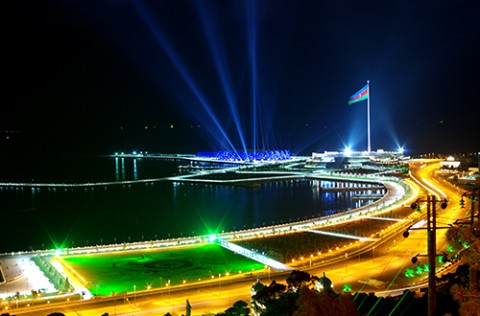Since some years, Azerbaijan experiences an immigration wave. Chart 1 shows the net immigration (immigration minus emigration) to Azerbaijan during the last 22 years. As can be seen, in every year since 2008 more people are immigrating to Azerbaijan than there are emigrating. In 2012, for instance, 2000 net migrants came to Azerbaijan.
Migration flows are governed by economic, social, and political motives. One may categorize these to be either pull factors or push factors. Push factors are typically the lack of economic opportunities in the countries of origin, failing governments, war, poverty, and other unpleasant circumstances that cause people to move away. Pull factors attract people to a particular destination country. The dynamic US economy, promising immigrants to ascend in their social status if they work hard, is such a pull factor. Providing to the unemployed decent social benefits, as it is practiced in many European countries, may pull migrants to Europe.
Azerbaijan does not offer the economic opportunities and high incomes of countries in North America and Western Europe, nor does it have a generous welfare state that provides transfers to new arriving immigrants. So what are the pull factors and the push factors behind the migration to Azerbaijan?
WHY AZERBAIJAN BECOMES ATTRACTIVE
Chart 2 shows the origins of those people who came to Azerbaijan between 2008 and 2012 and their numbers. Most immigrants came from the Russian Federation, in total more than 8000 persons. Arguably, many of these are ethnic Azerbaijanis who left their country during the last decades and returned recently.
One of the main pull factors is the economic development of Azerbaijan during the last years, as reflected in high gross domestic product (GDP) growth per capita and considerable poverty reduction. In the last years, the growth rate of the Azerbaijani economy was one of the highest in the world, peaking in 2006 with an incredible 34.5% (World Bank data). The reasons for this development go back to 1994, when Azerbaijan signed the so-called “Contract of the Century” with leading global oil companies. Driven by the extraction of oil, since the end of the Soviet Union the nominal GDP per capita almost quadrupled, standing now at around $7,500 (Georgia: $3,500). The poverty rate decreased from 50% in 2001 to 7.5% in 2011 (World Bank data), and the unemployment level is about 5-6 % with a decreasing trend.
The construction sector, particularly well-suited to absorb immigrants who lack qualifications, assumes an increasingly important role in the economy. The capital of Azerbaijan increases not only in population but also in the size of its residential areas. Places which were unpopulated 10 years ago are now full of new buildings. The metro was upgraded with many new stations and now reaches out to the suburbs of Baku. Recenlty, Hilton and Kempinski hotels opened. The promenade at the Caspian Sea was prolonged and renovated, and a grandiose building called “Crystal Hall” was constructed for the Eurovision Contest in 2012. The construction sector now takes the second place after the oil sector in terms of contribution to the GDP (the distance is rather large, however: while the oil sector accounts for around 50% to the GDP, construction contributes only 8%).
Push factors may be a hostile atmosphere Azerbaijanis face in some places of the Russian Federation. For example, in October 2013 an Azerbaijani man was blamed of killing a Russian boy in Moscow. There were demonstrations, riots, and even pogroms in Moscow against people from the Caucasus, especially Azerbaijanis.
MIGRATION NUMBERS TELL A STORY
The development of net migration into a country is an indicator not always fully appreciated by economists, who are somewhat fixated on the gross domestic product (GDP). The net migration reflects both specific historical events as well as the general development of a country. For example, if we look at Chart 1 again, it can be seen that in the beginning of the 1990s there was a considerable net emigration, around 55,000 people just in 1990. This emigration reflects both the collapse of the Soviet Union, which brought about economic decline, and the new freedom to travel. After decades of Soviet rule, Azerbaijanis for the first time had the chance to move abroad, and many made use of this opportunity. And the numbers also tell about the Nagorno-Karabakh conflict that escalated in those years and led many Armenians residing in Azerbaijan to leave the country. According to the Azerbaijan Statistics department, in the year 1989 there were 390,500 Armenians living in Azerbaijan.
While the GDP says something about the performance of the economy, it does not measure the overall quality of life well, which is only indirectly correlated with economic output. Quality of life also encompasses political freedom, safety, and even the richness of the natural environment. International migrants know which places that are nice for settling down, and if a country becomes a target of immigration, this is an achievement perhaps more impressive than high economic growth numbers.
This aspect is largely missing in the Georgian debate about immigration. If people like to come to Georgia, this is first and foremost an indicator of success. In the end, life in Georgia cannot be so bad if people want to exchange it for the lives in their home countries.


















Comments